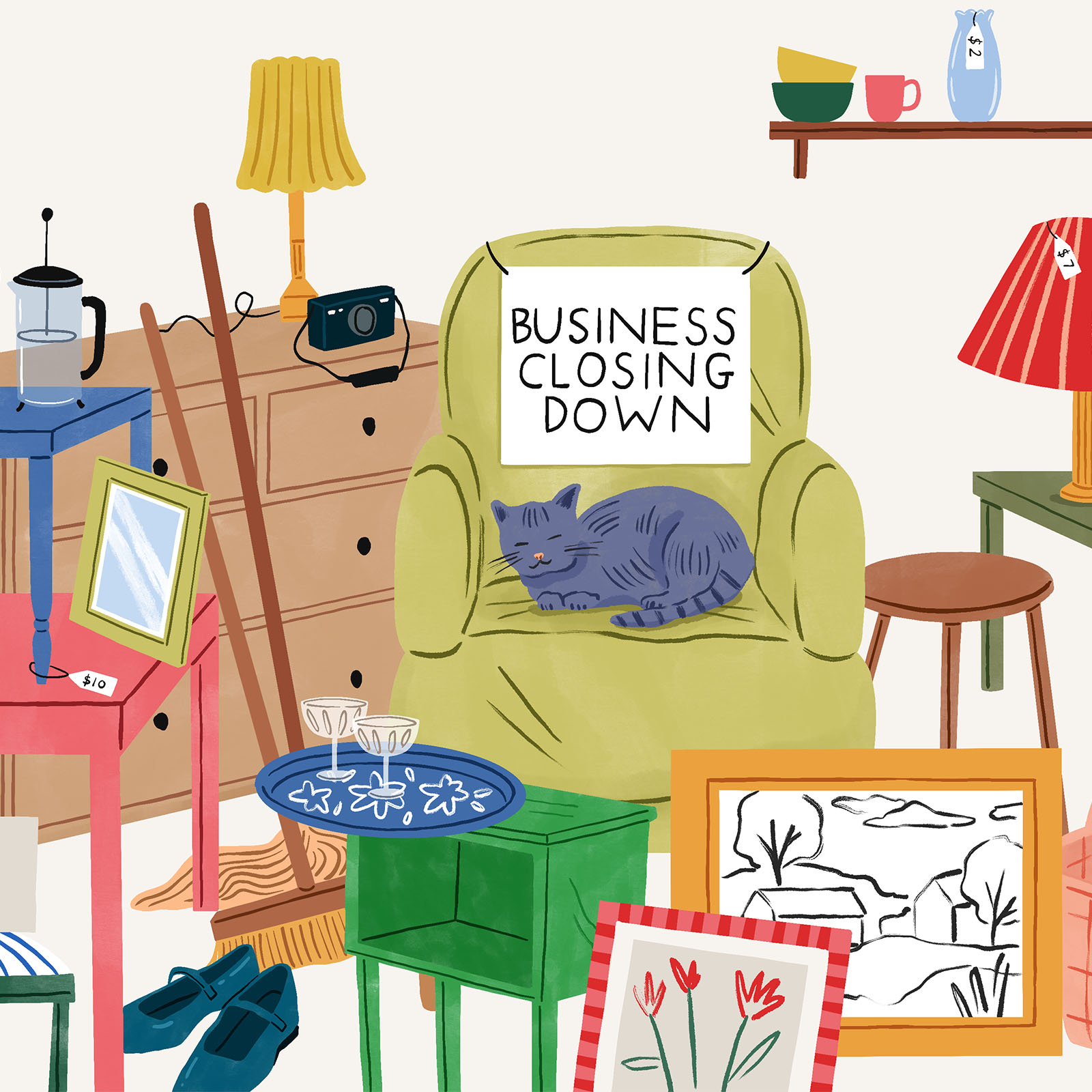Get Courier straight to your mailbox
You can unsubscribe at any time using the link in our emails. For
more details, review our privacy policy.
A weekly email explaining the relevance of one essential business concept to growing your business – featuring key terms, perspectives and useful tools.

As a founder, you'll probably want to sell your business when you're looking to realize value (ie, get a cash return) on all the time and money you've invested into the business. Here's how to do it right...
Read issue
When it comes to quitting your job, having a plan in place will help you make a more informed decision about when to take the leap. This way you can protect yourself and improve the chances of your business succeeding.
Read issue
Allowing your decisions to be informed by your budget will help your business thrive in the good times and stay protected in a downturn. That's why creating a formal budget is a key part of any successful business. Here's how to do it...
Read issue
Paying yourself can often get left to the bottom of a business owner's to-do list. Instead, put it at the top of your list.
Read issue
As a small business owner, there can be a temptation to keep everything in-house for as long as possible. Aside from saving you time, accountants will help you be more efficient with your money. Plus, there are plenty of small advisors who can provide basic accounting and tax advice for relatively low fees.
Read issue
Most business owners will look for a lawyer only when something goes wrong, but the opportunity cost of trying to do contracts yourself – both in terms of time and risk – usually justifies legal support as a sound investment.
Read issue
As people grow increasingly conscious of brands that are greenwashing, investing in a certification can demonstrate your business' commitment to environmental and social good. The B Corp certification process is one of the most rigorous certifications out there – and big and small businesses alike can put themselves forward for it.
Read issue
It's important for businesses – particularly small ones – to be intentional and strategic about who they send free products to and, by extension, which audiences they're targeting. After all, you don't want to put yourself out of inventory.
Read issue
Franchising might seem like it's only for large companies, but it's within reach for small businesses, too. If you've already established a brand and would like to expand out to new areas, franchising your business means that you don't have to shoulder the full responsibility of doing so. Here's how it works.
Read issue
An employee bonus scheme is a way of rewarding your team for doing a great job. That could be through giving them more vacation or equity – but it's usually with cold hard cash. But knowing when to introduce a bonus scheme – particularly as a small business with unpredictable revenue – can be challenging.
Read issue
If you encourage customers to creatively express themselves about your brand, they'll respond in kind.
Read issue
A board of advisors is very different to a board of directors. Advisors can't vote on topics and don't have any share in the business. They're there to provide advice – for you to use as you see fit.
Read issue
Your marketing and social media channels are likely set up to direct customers to your website. But, if visitors are landing on your homepage and don't take action, you need to work on your website conversion rate. Here's how to do it.
Read issue
Newsletters allow you to demonstrate your brand personality and cement yourself as an authority in your field. To maximize your chances of success, it's worth devising a considered strategy as you build your email newsletter from the bottom up.
Read issue
Negotiating payment terms with your suppliers can have an enormous impact on your bottom line. However, especially in the current climate – where cost increases are everywhere – you'll need to approach any negotiations carefully. Here's how to do it.
Read issue
Failure to follow the correct processes to shutter your business can lead to lawsuits and debts – well into the future. That's why coming up with a bespoke plan before you officially cease operations will stand you in very good stead.
Read issue
Product localization is about how you adapt your product or service to a new country or culture. Here's how to do it.
Read issue
If you want your business to maintain its point of difference, you'll likely want to protect your IP. To do so, there are three main tools at your disposal: trademarks, copyright and patents. Here's what you need to know.
Read issue
Working with recruiters can be great – but only if you take time to find the perfect fit. The key is to build a long-term relationship and immerse them in your culture, so that they understand your business and are incentivized to find you the best of the best.
Read issue
The role of a leader is to spot a need or opportunity for change and act decisively. That could be something minor (like switching to a new tool) or something radical (like pivoting the direction of the whole business). But the difference between a good leader and a great one is their ability to bring everyone along with them.
Read issue
A business line of credit (LOC) can be super helpful if you need to buy some new equipment, or if you're just tiding the business over during seasonal revenue fluctuations. It's a good tool to have in your funding arsenal, especially if cash flow is hard to predict – which is why it's a popular funding option for small businesses.
Read issue
Despite the name, this isn't a trick to keep staff locked into your company. Instead, it's a pre-emptive chat (that happens at least once a year) that creates a culture of trust and transparency.
Read issue
If your business is aspiring to delve into the physical retail world, pop-ups can be a no-brainer as a first step. They're a low-risk testing ground without the commitments, complexities or costs of a permanent space. Pulling one off, though, takes some work – before, during and after the event. Here's how to perfect popping up.
Read issue
You've got to find a way of maintaining or increasing profit margins – but it's a very risky strategy to pass on all your costs to the customer. This is a critical business decision and one that far too many founders spend far too little time on. You're going to need a considered, data-led, well-communicated strategy that looks to maintain long-term value for your business. Dig in.
Read issue
Micro influencers (people with social media followings of between 3,000 and 100,000) are a potential game changer for small businesses. With high engagement rates and established trust and authority in a specific niche, they can allow you to reach a whole new audience. But there's an art to doing it properly and achieving the focused aims you have in mind.
Read issue
Done poorly, performance reviews can be demotivating and unhelpful. Done well (as part of a wider development ecosystem), they can nurture employees and give employers a framework for rewarding good work. Read on for more tips on how to do it right.
Read issue
Rebranding could involve changing your logo, tone of voice, website design or even your business name. It's a marketing move as well as a sound business strategy – but the stakes are high when you're changing the very DNA of your business. Here's how to do it.
Read issue
Although it might seem like a small detail, an excellent job description can make a massive difference to the quality of applicants. After all, with top talent in such high demand, it's essential that you incentivize the right people to apply.
Read issue
A customer feedback loop is a way for a business to learn from the people that use its product or service – whether that's through email surveys, feedback forms or post-purchase follow-ups. It's known as a loop because you don't just gather feedback; you also respond to what people have to say, too.
Read issue
PR is all about managing your business' messaging and reputation. While you can handle this in-house, an external PR agency (or individual) can help define or refine your message and help you get it out there – whether that's through traditional press coverage, securing speaker slots on podcasts or even growing your social media channels.
Read issue
In the split second customers spend reading or hearing your brand's name, assumptions will be made. While you need to make sure that your name works from a branding, domain and social handle point of view, there's also the legal side to consider.
Read issue
Do you make physical products? Would you like to sell more of them? One way to do that is by getting them stocked in other businesses – whether that's a high-street retailer or an online store. Beyond the potential revenue benefits, you'll get access to a whole new (often larger) customer base – boosting your brand awareness and legitimacy. Here's how to do it.
Read issue
If you've decided that raising money from investors is right for your business, the first step is clarifying which kind of investors suit your situation. The next step is to get your affairs in order, so you're prepared to present your business in a compelling, watertight manner. Remember, this is about finding the right partner for your business.
Read issue
Integrating training into your employees' jobs is the essence of upskilling. Here's how to do it.
Read issue
Whether you need graphic designers, copywriters, marketers or coders, freelancers provide flexibility and expertise when and where you need it. But, to get the most out of them and build long-term, mutually beneficial relationships, you need a system in place so that both sides know what's expected. Here's how to do it.
Read issue
Succession planning is about protecting the value you've created and ensuring that your business continues to exist and (hopefully) thrive after you step away. It means stability and clarity instead of indecision, confusion and costly legal and organizational roadblocks. Plus, it can be a useful exercise even if you're not thinking of retirement any time soon.
Read issue
The impact a mentor can have is huge. Having someone you trust - and who you can talk to honestly - can boost your personal wellbeing and even improve your business' performance. That being said, finding the right person is key.
Read issue
A customer persona (or avatar) is a fictional profile that represents a particular target customer. Usually, businesses will have a handful of them to cover the majority of their customer base. Though these personas aren't real people, they're informed by data and research.
Read issue
Trademark infringement occurs when, whether by accident or design, a brand steers too close to another's intellectual property without permission. The results can get ugly – and expensive. Therefore, it makes sense to get ahead of this one – and take preventive steps to foolproof your brand identity and promotion methods, particularly online. Here's how to tackle it.
Read issue
To help someone who's struggling reach their full potential, you'll need a well-considered performance management strategy. Here's how to do it.
Read issue
In business talk, giving away freebies is known as product sampling. But it's costly to run a sampling campaign, and it takes some serious planning. You need to work out what you expect your return on investment to be and have a method of measuring the campaign's performance, so you don't waste your cash.
Read issue
Though not every business needs one, writing a business plan can add significantly to your credibility and act as a north star – whether it takes the form of a single PDF, a 12-slide presentation or a comprehensive 40-pager. Here's how to do it.
Read issue
If you're looking to raise external finance for your business, reaching out to those closest to you offers plenty of benefits that institutional investors don't. The catch is that mixing business and personal relationships is not without risks – here's what you need to know.
Read issue
Although it's always likely to flare up from time to time, knowing how to mitigate decision fatigue is essential for your business' survival and growth, as well as your mental health.
Read issue
Your visual identity is the impression created by the aesthetic elements associated with your business – AKA, its look and feel. That means that consistency across platforms, products and communications is essential. To achieve that, you'll need to create some guiding principles and design rules to follow as your business grows.
Read issue
An excellent customer education program will drive sales, improve usage and increase customer satisfaction. It'll also reduce the resource drain of solving complaints and queries. Here's how to guide your customers at every stage of their journey with your brand.
Read issue
A thought leader is someone recognized for their expertise and influence in a particular sector who shares their thoughts with the public. But here's the rub - it's not easy to do well.
Read issue
Pivots can be major, like changing the entire business model, or something more minor, like focusing efforts on one product line. But how you do it, and when, is critical.
Read issue
A growing business needs to get strategic about how it pays its employees. One very viable option is to bring in salary bands, a scalable pay structure that not only enables pay equity, but also provides flexibility and transparency to employees around pay progression, which can boost retention. It also helps you budget for future hires.
Read issue
Brand ambassadors spend time promoting your business – whether that's starting conversations about you within their networks, shouting about you on social media or showing up at events IRL. The right ambassadors can make a huge difference when it comes to spreading the word about what you do, which can have a knock‑on effect on sales, reputation, customer engagement and content creation.
Read issue
Transparency creates a strong employee culture, helps guide people on where they need to focus their efforts, and generally encourages a working environment of knowledge sharing. What's more, it's become a clear differentiator when it comes to attracting (and keeping hold of) talent.
Read issue
When you fund a business using your own money and any subsequent sales revenue, you're bootstrapping it. It's how the majority of small businesses are funded, and it builds financial sustainability into a brand from day one. But, if you start this journey without the necessary prep and foundations in place, there are both personal risks (debt, stress, burnout) and business ones (failure). To start the bootstrapping journey, you need to be in a sound economic position, have relatively low startup costs and have firm control over the financial situation of your business. Here's how to lay the foundations.
Read issue
Giving feedback to someone consists of saying: when you act in this way, this is the effect – whether that's positive or negative. The aim, of course, is to have an effect on someone's future behavior. But, despite knowing how important giving feedback is, plenty of managers and leaders find it tricky and avoid it – until small things become long-standing, ingrained issues. Here's how to do it right.
Read issue
Whether you're a product or service business, you'll probably be relying on suppliers – be it manufacturers, distributors, importers, infrastructure providers or subcontractors.
Read issue
Bartering – where two parties trade space, services, products or supplies without money entering the conversation – can be super valuable to small businesses with limited resources. It's a chance to obtain value without spending – and extract value from parts of your business that might otherwise have gone unused. But you need to be careful about what you offer and look to receive, and who you barter with. Sometimes the value doesn't match up; sometimes businesses end up giving away capacity they really need for their customers. Planning is key.
Read issue
More formal and structured than mentoring, coaching can be an incredibly useful investment in yourself, as a coach can provide motivation, practical suggestions and an impartial but informed perspective.
Read issue
Letting go of people who aren't contributing positively can make room for new talent and improve your culture and productivity. That said, the way you go about it is critical – and has a huge effect on the culture of your business, not to mention legal implications if it's not done right.
Read issue
If you want to diversify your brand's offering, one option is to move into a completely different area or category – leveraging your pre-existing identity, customer base and resources to create a new product or service.
Read issue
The aim of onboarding is to help employees assimilate into your company's culture and team as quickly as possible, while giving them all the critical info they need to perform their role. Naturally, a solid onboarding process requires a considered and often bespoke plan of action – something that's possible even for small businesses that don't have fully fledged HR departments.
Read issue
Got a never-ending to-do list? Well, priority management helps you apply yourself to where it really matters – and figures out the truly valuable tasks that have the biggest impact.
Read issue
Once you‘ve created a pitch deck, it’s time to work on the verbal side of things – and that means practice, practice and then just a little more practice. The aim is to correct inaccuracies and inconsistencies, cut out the fluff and make sure you deliver your pitch in a compelling and logical manner. Here’s what you need to know to stand out from the crowd.
Read issue
It seems obvious but it’s worth repeating: co-founder compatibility and characteristics can make or break a business. Spending time mining your network and beyond, and not just settling for someone who *seems* viable, can give your business what it needs to grow. This isn’t about hiring someone, it’s about finding someone to build your business with.
Read issue
When it comes to small-business grants, the application process is often very demanding and you’re unlikely to be the only business going for it. Here’s how to work out if grant funding is for you – and find the relevant ones to apply for.
Read issue
In the world of online shopping, product descriptions are king. To sell yours, you’ll want to provide the key info, answer any questions and ultimately persuade customers that what you’re selling is the answer to what they’re looking for.
Read issue
No matter what you’re doing, it’s pretty likely there are at least a few other businesses doing the exact same thing, targeting the exact same people. Digging into the details of your competitors’ product, their sales and marketing strategy or their customer experience can show you gaps you can exploit and help you keep up with how your sector is progressing in general. Here's how to do it.
Read issue
Finding the perfect manufacturer for production is a little like finding a needle in a haystack – but it’s one of the most important things you’ll do if your business is based on making – and selling – physical products. Here's how to find that needle.
Read issue
Idea sessions allow teams to think innovatively, present ideas, hear opposing viewpoints, riff off one another and improve upon those initial ideas. But to make them work, prep, structure, rules and strong leadership are non-negotiables. That’s where you come in…
Read issue
With many of the benefits and few of the risks of jumping straight into proper production or building, prototyping is a critical step in product development. The aim? To see what works and what doesn’t, what users are happy (and not so happy) with and what’s actually possible. Here’s how to tackle it.
Read issue
The word ‘networking’ carries plenty of baggage – so it’s perhaps better to think of this instead as relationship building with a dynamic of mutual support. Sharing knowledge and opportunities with like-minded people is fun and productive – if you do it right.
Read issue
If you’re experiencing stagnation in sales, or you’re ready for growth, a product line extension (also known as expansion) might be just what you need.
Read issue
In the absence of a dedicated HR team, the onus will fall on you to play an active role in conflict resolution – and hit the right balance between micromanaging and being too hands-off. Time to put on that mediating hat.
Read issue
A successful crowdfunding campaign takes serious work to make sure it reaches and resonates with the right people. Without further ado…
Read issue
With small businesses always a target for those pesky cybercriminals – and customers putting a lot of trust in you with their data – this is about building in best practice right from the start.
Read issue
If you’ve co-founded a business with another person, or people, then at some point – and the sooner the better – you’ll need to formalize roles and responsibilities. To avoid confusion – and conflict – setting down expectations at the start is essential. Here’s how to do it.
Read issue
Making impostor syndrome disappear is the aim, but keeping it in check is a more realistic goal – doing so is essential for your mental health and the health of your business. Here’s how to minimise its impact.
Read issue
This week, we’re looking at community investment – which can mean everything from hiring local to buying from local suppliers and supporting local initiatives: anything that keeps (or increases) money circulating within the community.
Read issue
Angel investors' knowledge, networks and cash can be invaluable when it comes to growing your business quickly – meaning there’s as much skill in the search as there is in convincing them to invest. Here’s how to avoid wasting your valuable time – or worse, giving away part of your business to the wrong people.
Read issue
One-on-ones are recurring discussions (every one or two weeks) between you and someone who works directly below you. In them, employees are given the time, space and platform to talk about whatever's important to them – work-related or not. But that’s only if you structure them properly.
Read issue
For small businesses, partnerships present a simple yet effective route to growth: helping build out your brand and reach new audiences, while making exciting, creative decisions with a lower level of financial risk attached. But any partnership or collab needs to be coordinated correctly because, whether they’re strong or weak, they affect the core identity of your product or service – and how both your employees and customers perceive it.
Read issue
Your pricing affects how people perceive what you're selling – as well as if, when and why they would buy it. Price it too high and you’ll miss out on sales; too low and you’ll sacrifice revenue for no reason and perhaps even cheapen your brand in the long run. That might not sound like the most creative of activities, but this should be treated as both an art and a science.
Read issue
Creating plans for hypothetical events might not be top of your priority list, but as you dig into it you’ll realise the value of some prep. You might even be able to turn a crisis into an opportunity – enriching relationships with your existing customers, and even gaining new ones.
Read issue
Although physical offices aren’t perhaps as important as they were pre-pandemic, finding the right space makes a huge difference: for happier and more productive staff, your attractiveness to potential hires and your brand’s image. It’s a balancing act between finding something you can afford and something that fits your business’ needs.
Read issue
Making sure your customers are happy is key to retaining them and encouraging them to recommend your business to others. Therefore, customer feedback should influence everything from your product development to your marketing strategy – getting this right is essential.
Read issue
Social media can feel like an overwhelming part of a business to manage, but it needn’t be – here’s what to do to create a consistent presence.
Read issue
With the rise of online shopping, the choice available to consumers in any given category can be vast – meaning the photos that illustrate what you’re selling and why it’s worth buying are fundamental if you’re selling online. This doesn’t necessarily require a lot of fancy equipment or a professional photographer – you just need to think through your goals and invest some time and energy into bringing those ideas to life. Here's how to do it.
Read issue
Making sales through outreach is notoriously hard – that’s why your strategy needs to be distinctive and relevant to your industry, product and prospects. Here's how to do it.
Read issue
Search engine optimisation (known as SEO) is about setting up your website so that search engines surface it when people search for questions or terms related to your business. Here's how to use it so your business can rank higher in search results.
Read issue
This week we tackle something that still plays a pretty big part in getting external investment: the pitch deck – the visual story of your business used to spark investor interest.
Read issue
This week, we tackle a subject that the vast majority of businesses could do with more of: getting press coverage in the right places. And there’s far more to it than sending out a few hopeful emails.
Read issue
Customer support has come a long way since the days of long hold times and infuriating conversations. Now you need to be supporting customers throughout their journey.
Read issue
This week, we’re digging into the world of compensation and the topic of pay equity – making sure that people are being paid fairly across your business.
Read issue
This week, we’re talking about how to use user research in your product development process to help you build something that meets customer needs and wants.
Read issue
This week, we tackle a fundamental aspect of management that plenty of founders have trouble with, which results in a waste of valuable energy that would be better spent elsewhere.
Read issue
It can seem counter intuitive, but you don’t necessarily own content that you pay to create. You might need to licence it from its creator – and if you do, you should have a good understanding of the usage rights available.
Read issue
For small businesses, getting the right people to join the team is critical – your interview process is not something that should be an afterthought or left to gut instinct.
Read issue
Here we tackle a pivotal step when launching a new business or product: the process of assessing the market – and determining where you’ll fit into it.
Read issue
This week, we turn our attention to a subject that's crucial to understanding your business' impact on the environment – and one not as complex, time-consuming or expensive as you might initially think...
Read issue
It goes without saying (but we’ll say it anyway) – word-of-mouth remains the most effective way for a business to acquire new customers. While that sometimes happens organically for free (very handy), businesses often need to encourage existing customers to refer their product or service to someone they know. Enter a referral marketing program.
Read issue
Once you’ve got a logo, colour scheme and name sorted for your business, it might seem like you have everything you need to build a strong brand. But one essential – yet often overlooked – brand dimension is tone of voice. At its simplest, your brand’s tone of voice is your personality. It determines how you speak to your customers online, on packaging, on social media – everywhere, really.
Read issue
Welcome to Courier Workshop, our new email dedicated to helping you launch, run and grow a successful business. This week, we’re starting with a question we hear time and again: how to fund a business with debt rather than equity. We hope you find it useful and of course, as always, we'd love to hear your thoughts.
Read issue